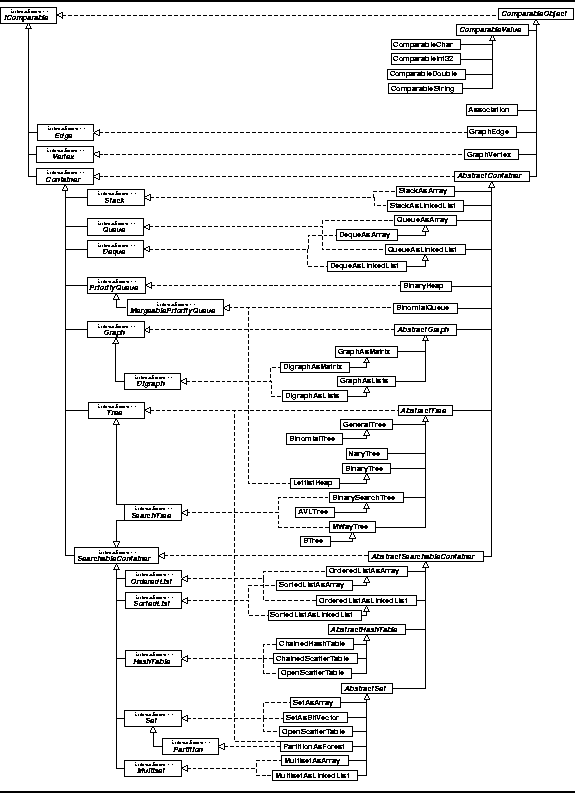|
Data Structures and Algorithms
with Object-Oriented Design Patterns in C# |
The C# class hierarchy which is used to represent
the basic repertoire of abstract data types is shown
in Figure ![]() .
Two kinds of classes are shown in Figure
.
Two kinds of classes are shown in Figure ![]() ;
abstract C# classes ,
which look like this
;
abstract C# classes ,
which look like this
![]() ,
and concrete C# classes ,
which look like this
,
and concrete C# classes ,
which look like this
![]() .
In addition, C# interfaces are shown like this
.
In addition, C# interfaces are shown like this
![]() .
Solid lines in the figure indicate the
specializes relation
between classes and between interfaces;
base classes and interfaces always appear to the left
of derived classes and interfaces.
Dashed lines indicates the the realizes relation
between a class and the interface(s) it implements.
In C# a class may specialize at most one other class
and it may realize any number of interfaces.
A C# interface may specialize any number of interfaces (but not classes).
.
Solid lines in the figure indicate the
specializes relation
between classes and between interfaces;
base classes and interfaces always appear to the left
of derived classes and interfaces.
Dashed lines indicates the the realizes relation
between a class and the interface(s) it implements.
In C# a class may specialize at most one other class
and it may realize any number of interfaces.
A C# interface may specialize any number of interfaces (but not classes).

Figure: Object class hierarchy.
A C# interface comprises a set of method and property declarations . An interface does not supply implementations for the methods or properties it declares. In effect, an interface identifies the set of operations provided by every class that implements the interface.
An abstract class in C# is a class which defines only part of an implementation. Consequently, it is not possible create object instances of abstract classes. In C# an abstract class may contain zero or more abstract methods or abstract properties . A abstract method or property is one for which no implementation is given.
An abstract class is intended to be used as the base class from which other classes are derived . By declaring abstract methods in the base class, it possible to access the implementations provided by the derived classes through the base-class methods. Consequently, we don't need to know how a particular object instance is implemented, nor do we need to know of which derived class it is an instance.
This design pattern uses the idea of polymorphism . Polymorphism literally means ``having many forms.'' The essential idea is that a C# interface is used to define the set of values and the set of operations--the abstract data type. Then, various different implementations (many forms) of the interface can be made. We do this by defining abstract classes that contain shared implementation features and then by deriving concrete classes from the abstract base classes.
The remainder of this section presents the
top levels of the class hierarchy which are shown in Figure ![]() .
The top levels define those attributes of objects which
are common to all of the classes in the hierarchy.
The lower levels of the hierarchy
are presented in subsequent chapters where
the abstractions are defined and
various implementations of those abstractions are elaborated.
.
The top levels define those attributes of objects which
are common to all of the classes in the hierarchy.
The lower levels of the hierarchy
are presented in subsequent chapters where
the abstractions are defined and
various implementations of those abstractions are elaborated.

Figure: Object class hierarchy.